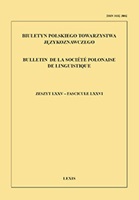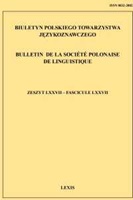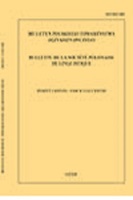
Profesor Aleksandra Cieślikowa (1936–2018)
In Memoriam Profesor Aleksandra Cieślikowa (1936–2018).
More...We kindly inform you that, as long as the subject affiliation of our 300.000+ articles is in progress, you might get unsufficient or no results on your third level or second level search. In this case, please broaden your search criteria.

In Memoriam Profesor Aleksandra Cieślikowa (1936–2018).
More...

In Memoriam Profesor Maria Teresa Lizisowa (1936–2019).
More...

Polish has grammaticalized the opposition perfectivity vs. imperfectivity using prefixes or suffixes attached to verbs or allomorphic and suppletive forms of verbs. This morphological opposition does not entail a clear semantic opposition. This article presents the attempts to find this meaning with respect to perfectivity. Discussing its different definitions, we show that they exclude certain groups of Polish verbs. The definition according to which a perfective verb represents a situation as a point does not apply to durative verbs (e.g. pol. zbudować ‘to build’). The definition according to which a perfective verb rep resents a situation that has reached a natural endpoint applies only to telic verbs, excluding others (e.g. pol. popracować ‘to work for a short period of time’). The definition according to which a perfective verb represents a situation in a retrospective manner fits, at the same time, verb forms with perfect meaning in those languages which grammaticalized it. The latter definition creates the risk of confusing perfectivity with perfectiveness, which is particularly unfortunate in contrastive linguistics. Therefore we argue that the most adequate is the so-called “holistic” definition of perfectivity, according to which a perfective verb represents a situation as a whole, which means that the speaker takes into account neither its development in time nor its subsequent phases.
More...
In Memoriam Dr hab. Kazimierz Długosz, prof. US (1935–2021).
More...

In Memoriam Profesor Bogusław Nowowiejski (1954–2019).
More...


The acceptability of the Polish M-word (corresponding to the N-word in English) has been debated in the social media. In the debate, the adversaries vary not only in their views, but also in ways they formulate and justify them. In the present paper, we analyze a sample of Facebook posts in which the authors not only express the opinions of Polish Blacks as a key argument in favor of rejecting the M-word, but also argue that giving hearing to Black voices shows regard for the well-being of the Other. On the other hand, we assume that such posts may constitute Face Threatening Acts against those who consider the M-word non-offensive. Therefore, we study the degree to which politeness strategies are employed by the authors to weaken this threat. The analysis presented in the paper is only qualitative, while the adopted interdisciplinary perspective draws on sociology and linguistics.
More...
The article is devoted to the occurrence of the main exponents of the concept of porządek społeczny [social order] in Old and Middle Polish texts, i.e. the lexemes: rząd – the earliest one, porządek – the most frequent one, and ład – the most recent and rare. The analysis explores the nominal collocations of these items, which indicate semantic relations with other words. The analysis enables us to discover the links between the concepts to which they refer, but it is not sufficient to establish their nature in an accurate manner. There is an indication of 1) a strong interdependence of the early social order and law, 2) of the superiority in reference to a number of concepts which represent the sphere of social relationships, such as zgoda [harmony] and pokój [peace], 3) of a relationship that is akin to resulting in respect to utilitarian concepts, such as bogactwo [opulence] and zapobiegliwość [foresight], and 4) of the ambiguous relationship with the concepts of wolność [freedom] and sprawiedliwość [justice]. The place of social order in the sphere of social concepts was established during the Renaissance and remained stable until the end of the Middle Polish period, whereas the concept itself was associated at that time with a positive axiological charge.
More...
The text deals with the limitations of the categorization process of the classes of diminutive and similative derivatives in Middle Polish. The aim of the study was to identify the potential reasons for the blocking of the categorization processes of the historical classes of diminutives and similatives. The methodology and terminology used in the paper follows the achievements of the so-called “Katowice school of historical word-formation”. The 1764 trilingual dictionary by M.A. Troc (Volume 3, with Polish as the input language) was the main source of lexical material. Based on the analysis of the presented material, one can conclude that the linguistic awareness of the lexicographer, manifested through the organization of dictionary entries and the choice of foreign equivalents and their definitions, may shed a new light on the categorical system of historical derivatives. In lack of sufficient Polish-language contexts, the translational character of lexicographic sources lets us gain information about the semantic and stylistic value of Polish lexical units on the basis of their foreign equivalents or their foreign-language definitions provided by dictionaries. The category of diminutive names in the second half of the 18th century did not yet crystallize its dominants, and the class of similative names had a similar formal and semantic status. Both classes constituted products of sets that contained derivative units, assuming a diminishing or similative function. The factor that inhibited the process of the crystallization of the dominants in the mentioned classes was the extremely high level of word-formation tautology, which did not allow language users to identify the real functions of multifunctional formants with the basic consonants -k- and -c-.
More...
An intermediate stage of the formation of reported speech can be observed in the Old Polish period. Polish medieval texts include mixed constructions in which the conjunction że (iż/iże), expressing a subordinate relation and typically introducing reported speech, introduces direct speech. Using Old Polish apocrypha as the source of data, the paper examines the relation between these constructions and Latin sources. The analysed constructions often appear in places where in the source text there were constructions unknown to the Polish language, such as Accusativus cum infinitivo, or where the quotation in the source text was introduced by a quia that could introduce indirect and indirect speech or be, as a particle, part of the quotation itself. Mixed constructs also appear in places where the compilation boundary coincides with the introduction of a quotation. Another problem for Old Polish authors was the overlapping of the levels of the plot and the nonfiction reality.
More...
The article addresses the interrelations between linguistics (onomastics) and the language of the law. The study includes three categories of proper nouns: anthroponymy, toponymy and chrematonymy, and the aim is to discuss the relation between names seen as cultural texts and legal texts, in which issues related to the functioning of both of these onimic categories are discussed. The study focuses on the process of the formation of surnames and on the changes allowed by law in the area of names and surnames. It also discusses the latest regulations that concern place names, city names, and product names. Apart from showing the interrelations between the law and linguistics, the author pinpoints significant differences in the defining and interpreting of concepts (e.g. in the case of product names).
More...

The article discusses the methods of identifying Polish inflectional forms that contain the orthographic dyad from the set: dz, dź, dż and rz, which denotes two phonemes. The mentioned structures are mainly monophonematic, so the biphonematic occurrences can be considered exceptional. This issue is important for language processing, mainly for the automatic conversion of an orthographic text into phonological or phonetic transcription. This function is served by the multilayer transcription model proposed by the author. The paper briefly presents the assumptions of this model in the context of the problem discussed. The most important part of the article is the description of the research, whose aim was to determine onset orthographic sequences that appear only in certain inflectional forms, which enables their identification.
More...
The aim of this paper is to describe the way Ronald Langacker employs the notion of concept, one of the basic terms developed within conceptual semantics. The present discussion of the term concept focuses on the function it serves in the description of both (i) the semantic structures based on “schematized patterns of activity abstracted from everyday bodily experience” (Langacker 2008: 32) and (ii) the conceptualization processes based on the content and its construal. By comparing concept with other important terms, e.g. conceptualization, content, conceptual construction, primitive concept, minimal concept, conceptual metaphor, and conceptual integration, the author of the paper strives to delineate the specificity and status of the discussed notion in Langacker’s Cognitive Grammar. In the final part of the paper, we compare and contrast Langackerian concept with the notion of cultural concept used in selected Russian linguistic works and by Polish ethnolinguists.
More...
Review of: Recenzja książki Małgorzaty Nowakowskiej: Rezultatywność w języku francuskim i polskim, Kraków: Wydawnictwo Naukowe Uniwersytetu Pedagogicznego, 2020
More...
Review of: Recenzja książki Zofii Bilut-Homplewicz: Prinzip Perspektivierung. Germanistische und polonistische Textlinguistik – Entwicklungen, Probleme, Desiderata. Teil II: Polonistische Textlinguistik (Danziger Beiträge zur Germanistik, Band 61. – Berlin: Peter Lang GmbH, 2021, s. 172)
More...